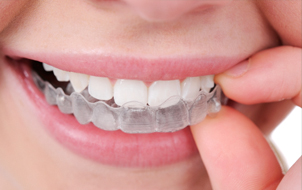Early Treatment
When is the best time to begin orthodontics?
The American Association of Orthodontists recommends that the initial orthodontic evaluation should occur at the first sign of orthodontic problems or no later than age 7. An early examination does not always result in immediate treatment. After evaluating your child, Dr. Mibab may simply want to monitor your child periodically while the permanent teeth erupt and the jaws and face continue to develop. The initial examination and periodic reevaluation are complimentary appointments!
What are the benefits of early orthodontic evaluation?
Early evaluation allows Dr. Mibab to detect potential orthodontic problems related to jaw growth and eruption of the adult teeth. This allows greater opportunity for more effective treatment. Early interceptive treatment, or phase one therapy, is designed to guide and enhance a child’s natural growth to establish proper jaw size, improve space for the eruption of permanent teeth and improve the position of the upper and lower jaws in relation to one another.
Why is age 7 considered the optimal time for screening?
By the age of 7, the permanent first molars have erupted, establishing the back bite. Children between the ages of 7 and 10 are best suited for early treatment because their growth potential is still at a maximum. Treatment usually lasts 9 to 12 months after which the child is monitored while the remaining permanent teeth erupt. Most children will require a second, more comprehensive, phase of treatment in order to perfect the alignment of all teeth and create a completely stable, functional and aesthetic occlusion.
What are the advantages of early treatment?
- Creating room for crowded, erupting teeth
- Creating facial symmetry through influencing jaw growth
- Reducing the risk of trauma to protruding front teeth
- Preserving space for unerupted teeth
- Reducing the need for permanent tooth extractions
- Reducing treatment time with braces
- Improve the eruption pattern of permanent teeth
- Correct harmful oral habits
- Improve esthetics and self-esteem
- Expand the upper jaw to correct a crossbite
- Reduce the likelihood of impacted permanent teeth
- Improve some airway and speech problems
Why should malocclusions be treated?
According to studies by the American Association of Orthodontists, untreated malocclusions can result in a variety of problems. Crowded teeth are more difficult to properly brush and floss, which may contribute to tooth decay and/or gum disease. Protruding teeth are more susceptible to trauma. Crossbites can result in unfavorable growth and uneven tooth wear.


 Many thanks to Dr. Mibab and his staff for helping my children have the beautiful smiles and confidence they have today AND for their community contributions!
Many thanks to Dr. Mibab and his staff for helping my children have the beautiful smiles and confidence they have today AND for their community contributions! 























